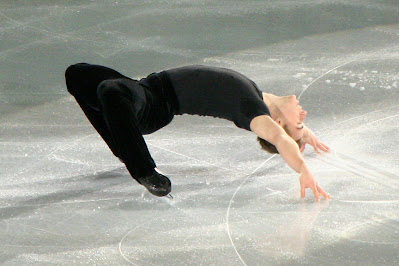THE CANTILEVER
If you don't dance and just pull up your pants, you might be leaning back... and that's how the Cantilever is done. A variation on the spread eagle, a common skating move in the field where skaters glide on both feet, toes turned outward to the sides with heels facing each other, the Cantilever is a thrilling and gravity inspiring skating element with it's historical origins in early show skating.
The Cantilever was invented by Werner Groebli, a Swiss skater who moved to the U.S. in 1937 and joined the cast of Ice Follies as a comedic show skater in 1939. In his long career as a professional figure skater, Groebli estimated he performed more than 12,000 shows before retiring at age 65 after injuring himself while skating in 1980 after an untimely collision with the boards. He performed the "backbend Cantilever" as a signature element with his skating partner. While Frick Cantilevered, Frack would skate in the other direction, hydroblading. The Cantilever can best be described as an element that sees skaters take on an inside spread eagle position and contort their bodies so that they are leaning backwards in a layback position with their head almost touching the ice. Adapted from Groebli ("Mr. Frick")'s comedic routines with Hansruedi Mauch ("Mr. Frack"), the contortionist like trick has been popularized by show skaters and ISU eligible athletes for decades since then, among them Canada's Shawn Sawyer, America's Doug Mattis and Ross Miner, Sweden's Adrian Schultheiss, Russia's Ilia Klimkin and even the Russian pairs team of Lubov Iliushechkina and Nodari Maisuradze, who have incorporated the spectacular and awe inspiring trick as both a solo and pair connecting movement in their programs.
HYDROBLADING
Hydroblading, a term coined by Uschi Keszler, the coach of World Champions Shae-Lynn and Victor Kraatz, who popularized the move is an extension of a deep inside or outside edge with the skater's body stretched in a very low and horizontal position to the ice. The most common version of hydroblading is on a back inside edge, with the skater's free leg crossed behind and the knee deeply bend and extended outside the circle, with the upper body leaning into the circle. I used to love hydroblading when I skated, and would always start by doing a back shoot the duck position then leaning into the edge and coming up in a back spin. It's certainly a dramatic move when performed well and definitely showcases the strength of skater's edges.
FLY HIGH, SAY BYE
Isabelle Brasseur and Lloyd Eisler were 1993 World Champions, and after turning professional, basically wrote the book on dangerous and crowd pleasing adagio pairs tricks, inventing many new adagio moves including the "Fly High, Say Bye", where Lloyd basically tosses Isabelle over his head like a pizza pie, catches and releases her. It's one of many acrobatic tricks that Isabelle and Lloyd invented, many of which have not been performed since or certainly not with the same confidence.
THE BACKFLIP
If you want the audience to go beserk, you might want to do a backflip. It is a standard of professional skating, mainly because it was banned from ISU/amateur competition after Terry Kubicka performed it at the 1976 Olympic Winter Games and the association deemed it too dangerous. A backflip is essentially just as it sounds - a reverse somersault in the air. Many skaters have performed it over the years - from Scott Hamilton to Brian Orser to Robin Cousins and Ryan Bradley, among countless, countless others. A smaller group of women have ever successfully attempted this move - Lori Benton, Ashley Clark, Rory Flack Burghart among them. Surya Bonaly lands it both on two feet, and daringly, on one foot and straight into a double or triple Salchow. Now that's just cray cray! Even more cray cray is an adaptation that Michael Weiss performs, where he actually twists in the air while performing this daring move. I don't know how skaters do it, and still think it's the coolest thing ever. Just putting that out there.
THE HEADBANGER
Show skating wouldn't be what it is without these gravity defying tricks of the trade or the skaters who dazzle the world with them. With so many other ingenius and creative movements and acrobatic feats out there, especially with the popularity of adagio pairs skating and some of the completely outrageous show act skating we see featuring aerial acrobatics, fire eating, barrel rolls and even Gary Beacom and Gia Guddat with skates on their hands, the old saying "everyone has a gimmick" rings true in every good professional figure skater's resume. The fact of the matter is, there's nothing wrong with a gimmick here and there. The goal of show skating is to thrill and entertain an audience, and if you can find a trick to it you're a step above the rest.
Skate Guard is a blog dedicated to preserving the rich, colourful and fascinating history of figure skating. Over ten years, the blog has featured over a thousand free articles covering all aspects of the sport's history, as well as four compelling in-depth features. To read the latest articles, follow the blog on Facebook, Twitter, Pinterest and YouTube. If you enjoy Skate Guard, please show your support for this archive by ordering a copy of the figure skating reference books "The Almanac of Canadian Figure Skating", "Technical Merit: A History of Figure Skating Jumps" and "A Bibliography of Figure Skating": https://skateguard1.blogspot.com/p/buy-book.html.



